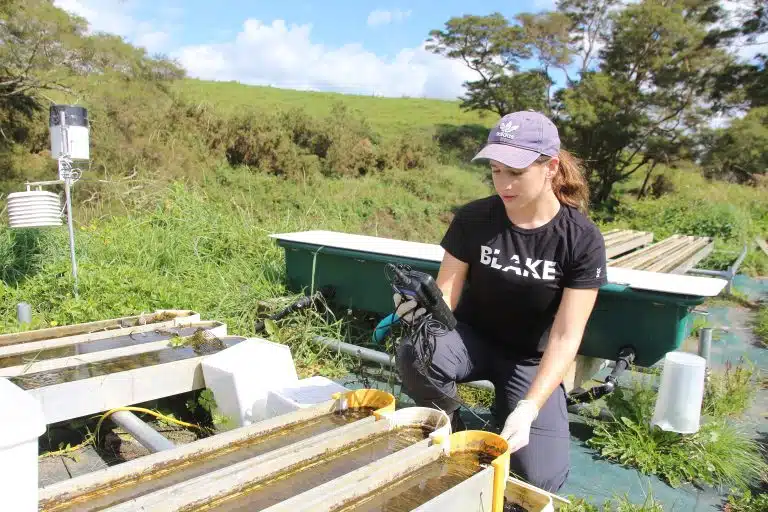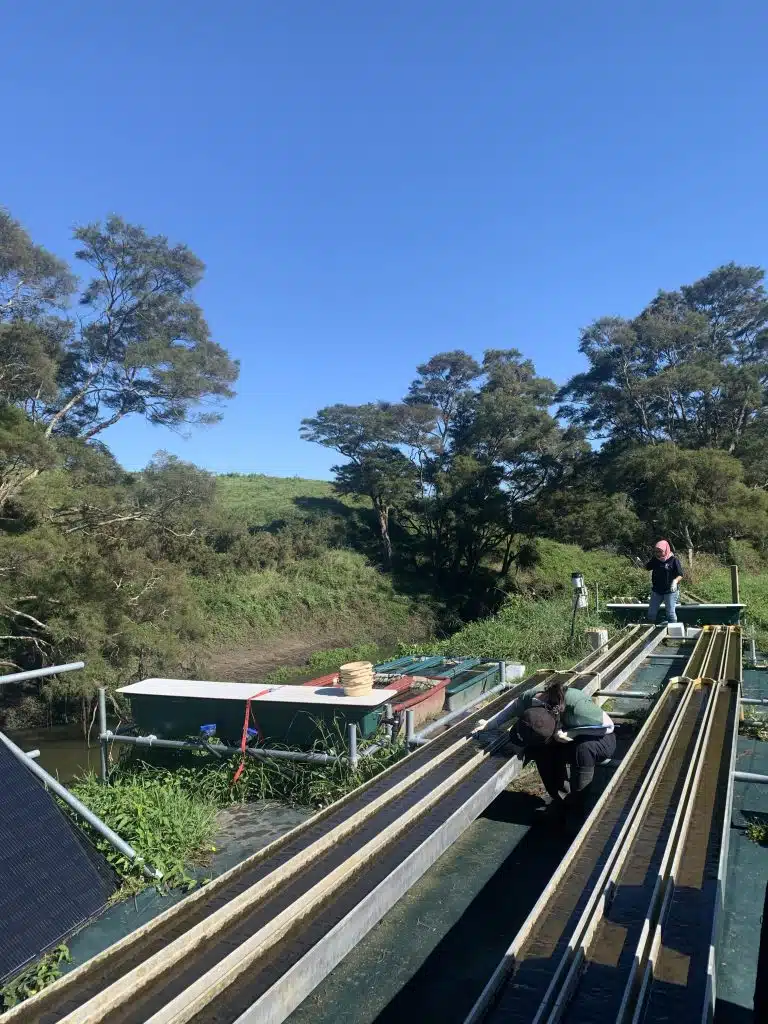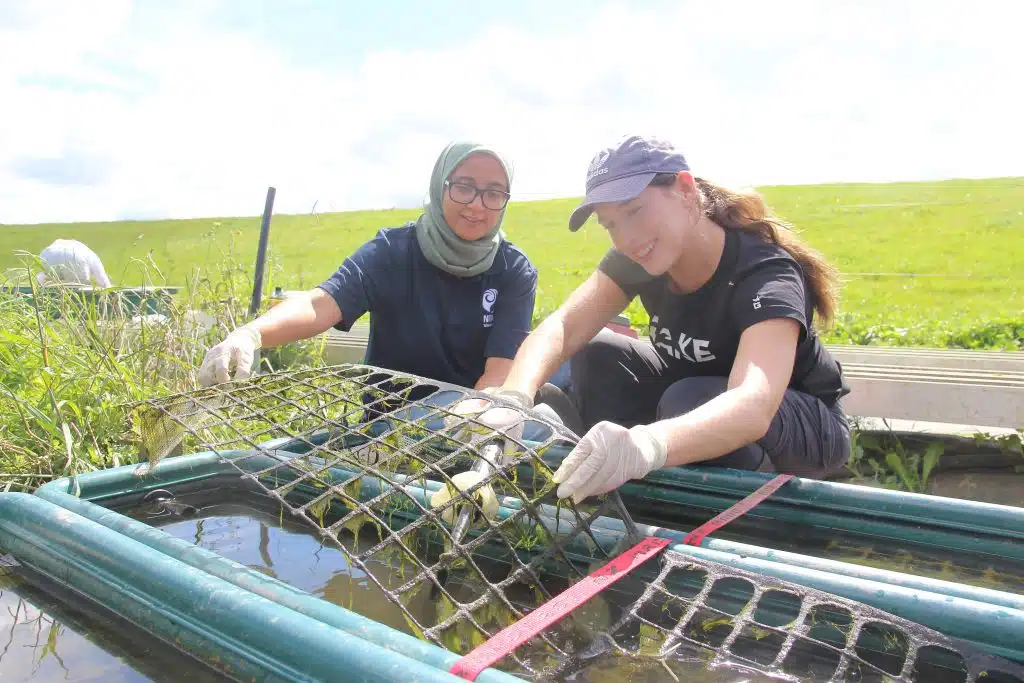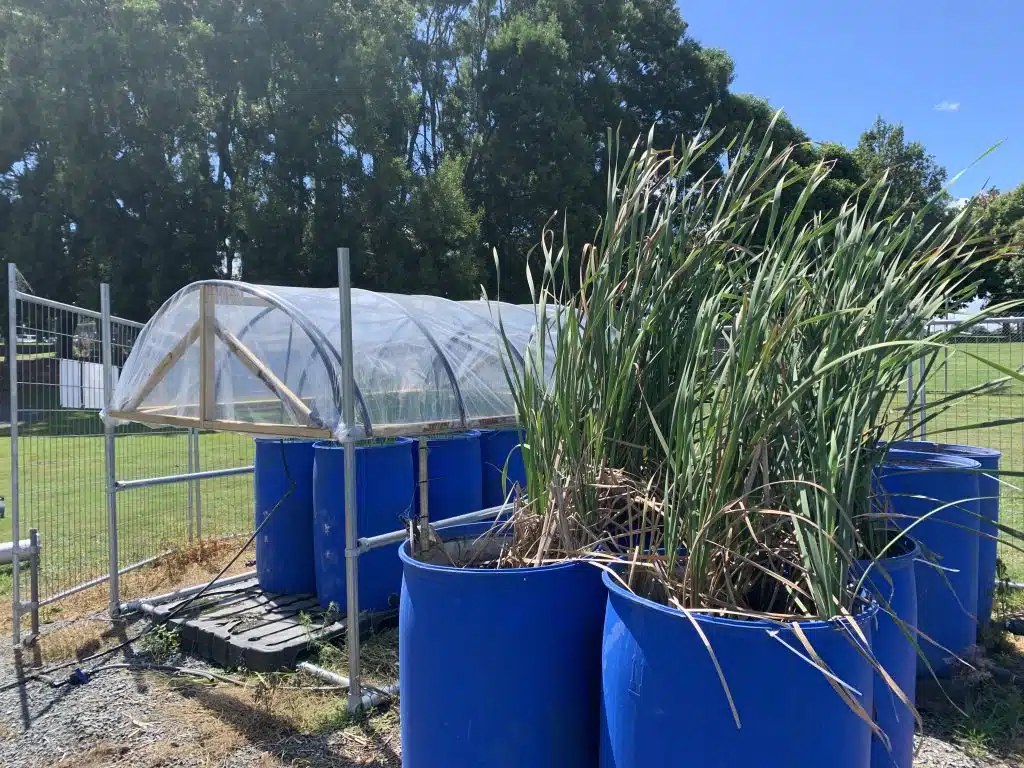Kia ora, I’m Grace – a Master’s of Science graduate from the Waikato. As this year’s NIWA freshwater representative for the BLAKE Ambassadorship programme, I got to take a peek at some of the key research projects taking place within NIWA’s aquatic pollution mitigation team.
Under the guidance of Dr. Rupert Craggs, I spent a fortnight at NIWA’s experimental research compound in Ruakura and in the field. The aquatic pollution mitigation team investigates how we can apply cutting-edge solutions to environmental issues that impact the quality of our water resources – namely, they investigate nature-based strategies for treating wastewater and mitigating freshwater pollution.
Week 1
While municipal wastewater treatment systems work well, they’re highly engineered and expensive. For something like a dairy farm, a small-scale, practical, and affordable water treatment solution is the way to go for future-proofing farming in the face of global change.
Introducing the FANS (Filamentous Algae Nutrient Scrubbers) experiment – this is the major showstopper I’m learning about during my time here. Filamentous algae produce no toxic effects, and is noticeable for its stringy, slimy, mat-like growth. Every week for now over a year, the aquatic pollution mitigation team has set out to study two farms in the Waikato with an operational FANS system set up to cleanse river water impacted by nutrient leaching. Propelled by solar power, river water is pumped up to the site and gently flows through long channels (floways), slightly sloped so that gravity allows the water to encounter filamentous algae as it trickles downwards. At the outflow, the water is conveyed back into the river. In the process, algae filter the water by taking up nitrate and phosphorus into their cell walls.
To monitor whether the system is successful, we’re measuring several parameters of water quality (such as pH and dissolved oxygen) and taking samples for nutrient analysis at the point that water enters and exits the floways. We know the algae are successful if water at the end of the floway has lower nutrient concentrations and better water quality indicators compared to water at the inflow point. We’re also harvesting algae each week (weekly harvesting is purely intended for the research phase of the treatment system) to gain a comprehensive dataset on how quickly algae grow, as well as how much the algal biomass fluctuates from week to week, and season to season. These data will help us understand how we can evaluate FANS systems’ productivity.
Week 2
I travelled with NIWA researcher James Sukias to Tauranga, where we checked up on some groundwater stations and retrieved data loggers monitoring wetlands in Tauranga. We also visited NIWA’s experimental setup at the Pukete wastewater treatment plant. Here, the team is testing the ability of different wetland plant species to assist in de-watering both digested/primary and activated/secondary sludge (i.e., sludge that has been collected in anaerobic conditions – without oxygen – versus in aerobic conditions – with oxygen).
De-watering is a critical step that separates the solid and liquid components of wastewater. Usually, it’s a mechanical process that requires huge power inputs. Hence, wetlands designed to dewater and treat wastewater can provide a sustainable, eco-friendly, and potentially super-efficient solution to an important (if rather un-glamorous) issue.
Just as natural wetlands are vital for filtering, storing, and slowly releasing water in our landscape, I think that constructed wetlands have enormous potential for treating wastewater – if time and space are not huge constraints. I considered myself a wetland advocate before, too, but after seeing how well even a single plant can control the smell and sight of wastewater sludge, I’m even more convinced.
Out of the plant species tested, Baumea in the activated sludge seems to be doing particularly well. As for next steps from here, the team talked about making further investigations into different sludge loading rates (to understand how much sludge a single plant can handle) and measuring different metrics to see just how effectively wetland planting could help with sludge treatment.
What I took away from the experience
I’m not a complete newbie to the world of research, but this experience opened my eyes to research outside of my scope. The BLAKE Ambassadorship was incredibly valuable and allowed me to make connections with fantastic people doing great work. Once again, I’m in awe of the sheer skill, smarts, and grit shown by technicians and researchers alike as they solve hundreds of problems along the road to creating experiments that will make a huge impact. Throughout this hard work is a clearly imbued passion for conserving our freshwater resources that is, quite frankly, inspirational.
I come with a background in terrestrial ecology, having completed my Master’s in the field of urban forest restoration, and some (preliminary) experience within the context of topics like variability in Mānuka nectar properties, mesofauna identification for kauri forests with or without dieback, identification of introduced dung beetles for NZ farms, and understanding how soil microbial communities change when we restore forests in urban areas.
Academia tends to encourage specialisation, to the extent that scientists often bemoan the construction of academic ‘silos’ – that is, where deep learning in one field is prioritised over interdisciplinary collaboration. So, for me, learning about freshwater research early on in my scientific career was an eye-opening, refreshing opportunity to extend my thinking laterally for years to come. After all, our terrestrial and freshwater environments provide constant feedback to one another.
After my BLAKE Ambassadorship is completed, I’ll be joining Manaaki Whenua as a research technician on projects related to land use and ecosystems; where learning a little about aquatic pollution mitigation will no doubt prove symbiotic to understanding a land-based lens on environmental issues. In the future, I hope to continue working in environmental conservation and restoration – and communicating the science I learn about.
A huge thank you to the team at NIWA for their kindness, patience, and enthusiasm in making this a wonderful experience. And of course, a massive thanks to the BLAKE team for granting me this opportunity.





